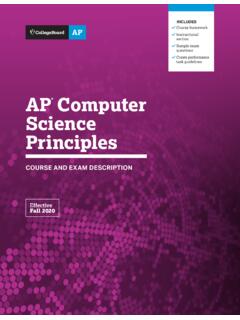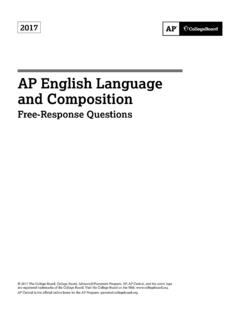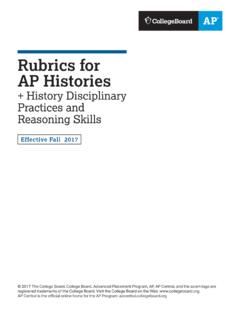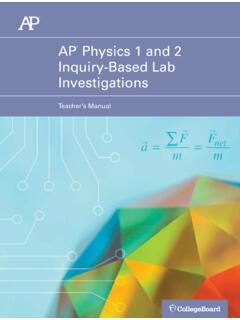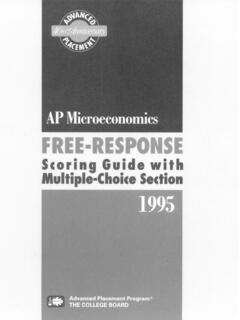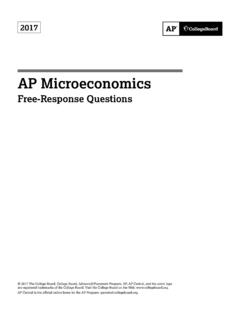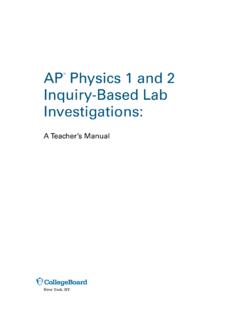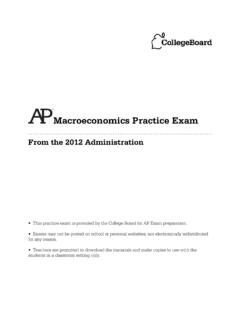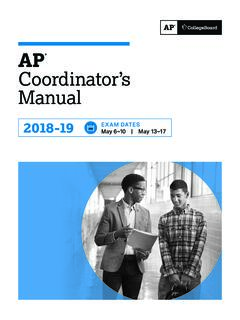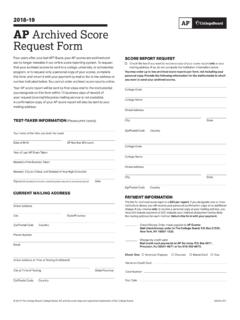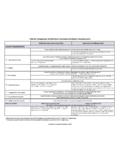Transcription of AP Computer Science A
1 AP Computer Science AScoring Guidelines2021 2021 College Board. College Board, Advanced Placement, AP, AP Central, and the acorn logo are registered trademarks of College Board. Visit College Board on the web: Central is the official online home for the AP Program: Computer Science A 2021 Scoring Guidelines 2021 College Board Applying the Scoring Criteria Apply the question scoring criteria first, which always takes precedence. Penalty points can only be deducted in a part of the question that has earned credit via the question rubric. No part of a question (a, b, c) may have a negative point total. A given penalty can be assessed only once for a question, even if it occurs multiple times or in multiple parts of that question.
2 A maximum of 3 penalty points may be assessed per question. 1-Point Penalty v) Array/collection access confusion ([] get) w) Extraneous code that causes side-effect ( , printing to output, incorrect precondition check) x) Local variables used but none declared y) Destruction of persistent data ( , changing value referenced by parameter) z) Void method or constructor that returns a value No Penalty Extraneous code with no side-effect ( , valid precondition check, no-op) Spelling/case discrepancies where there is no ambiguity* Local variable not declared provided other variables are declared in some part private or public qualifier on a local variable Missing public qualifier on class or constructor header Keyword used as an identifier Common mathematical symbols used for operators ( <> ) [] vs.
3 () vs. <> = instead of == and vice versa length/size confusion for array, String, List, or ArrayList; with or without ( ) Extraneous [] when referencing entire array [i,j] instead of [i][j] Extraneous size in array declaration, , int[size] nums = new int[size]; Missing ; where structure clearly conveys intent Missing { } where indentation clearly conveys intent Missing ( ) on parameter-less method or constructor invocations Missing ( ) around if or while conditions *Spelling and case discrepancies for identifiers fall under the No Penalty category only if the correction can be unambiguously inferred from context, for example, ArayList instead of ArrayList.
4 As a counterexample, note that if the code declares "int G=99, g=0;", then uses "while (G < 10)" instead of "while (g < 10)", the context does not allow for the reader to assume the use of the lower case variable. AP Computer Science A 2021 Scoring Guidelines 2021 College Board Question 1: Methods and Control Structures 9 points Canonical solution (a) 5 points (b) 4 points AP Computer Science A 2021 Scoring Guidelines 2021 College Board (a) scoreGuess Scoring Criteria Decision Rules 1 Compares guess to a substring of secret Responses can still earn the point even if they only call (guess) Responses will not earn the point if they use == instead of equals 1 point 2 Uses a substring of secret with correct length for comparison with guess Responses can still earn the point even if they only call (guess) use == instead of equals 1 point 3 Loops through all necessary substrings of secret (no bounds errors)
5 Responses will not earn the point if they skip overlapping occurrences 1 point 4 Counts number of identified occurrences of guess within secret (in the context of a condition involving both secret and guess) Responses can still earn the point even if they initialize count incorrectly or not at all identify occurrences incorrectly 1 point 5 Calculates and returns correct final score (algorithm) Responses will not earn the point if they initialize count incorrectly or not at all fail to use a loop fail to compare guess to multiple substrings of secret count the same matching substring more than once use a changed or incorrect guess length when computing the score 1 point Total for part (a) 5 points AP Computer Science A 2021 Scoring Guidelines 2021 College Board (b)
6 FindBetterGuessScoring Criteria Decision Rules 6 Calls scoreGuess to get scores for guess1 and guess2 Responses will not earn the point if they fail to include parameters in the methodcalls call the method on an object or classother than this1 point 7 Compares the scores Responses will not earn the point if they only compare using == or != fail to use the result of the comparisonin a conditional statement1 point 8 Determines which of guess1 and guess2 is alphabetically greaterResponses can still earn the point even if they reverse the comparison Responses will not earn the point if they reimplement compareTo incorrectly use result of compareTo as ifboolean1 point 9 Returns the identified guess1 or guess2 (algorithm)Responses can still earn the point even if they call scoreGuess incorrectly compare strings incorrectlyResponses will not earn the point if they reverse a comparison omit either comparison fail to return a guess in some case1 point Total for part (b)
7 4 points Question-specific penalties None Total for question 1 9 points AP Computer Science A 2021 Scoring Guidelines 2021 College Board Applying the Scoring Criteria Apply the question scoring criteria first, which always takes precedence. Penalty points can only be deducted in a part of the question that has earned credit via the question rubric. No part of a question (a, b, c) may have a negative point total. A given penalty can be assessed only once for a question, even if it occurs multiple times or in multiple parts of that question. A maximum of 3 penalty points may be assessed per question. 1- Point Penaltyv)Array/collection access confusion ([] get)w)Extraneous code that causes side-effect ( , printing to output, incorrect precondition check)x)Local variables used but none declaredy) Destruction of persistent data ( , changing value referenced by parameter)z) Void method or constructor that returns a valueNo Penalty Extraneous code with no side-effect ( , valid precondition check, no-op)
8 Spelling/case discrepancies where there is no ambiguity* Local variable not declared provided other variables are declared in some part private or public qualifier on a local variable Missing public qualifier on class or constructor header Keyword used as an identifier Common mathematical symbols used for operators ( <> ) [] vs. () vs. <> = instead of == and vice versa length/size confusion for array, String, List, or ArrayList; with or without ( ) Extraneous [] when referencing entire array [i,j] instead of [i][j] Extraneous size in array declaration, , int[size] nums = new int[size]; Missing ; where structure clearly conveys intent Missing { } where indentation clearly conveys intent Missing ( ) on parameter-less method or constructor invocations Missing ( ) around if or while conditions*Spelling and case discrepancies for identifiers fall under the No Penalty category only if the correction canbe unambiguously inferred from context, for example, ArayList instead of ArrayList.
9 As acounterexample, note that if the code declares " int G=99, g=0;", then uses " while (G < 10)"instead of " while (g < 10)", the context does not allow for the reader to assume the use of the lowercase Computer Science A 2021 Scoring Guidelines 2021 College Board Question 2: Class Design 9 points Canonical solution 9 points AP Computer Science A 2021 Scoring Guidelines 2021 College Board CombinedTableScoring Criteria Decision Rules 1 Declares class header: class CombinedTable and constructor header:CombinedTable(SingleTable ___, SingleTable ___) (must not be private)Responses can still earn the point even if they declare the class header as class CombinedTable extends SingleTable1 point 2 Declares appropriate private instancevariables including at least twoSingleTable referencesResponses can still earn the point even if they declare an additional instance variable to cache the number of seats at the combined table Responses will not earn the point if they declare and initialize local variables inthe constructor instead of instancevariables declare additional instance variable(s)
10 That cache the desirability rating omit keyword private declare variables outside the class1 point 3 Constructor initializes instance variables using parameters Responses can still earn the point even if they declare and initialize local variables in the constructor instead of instance variables 1 point 4 Declares header: public boolean canSeat(int ___)1 point 5 Calls getNumSeats on a SingleTable object Responses can still earn the point even if they call getNumSeats on constructorparameters or local variables of typeSingleTable in the constructorResponses will not earn the point if they call the SingleTable accessormethod on something other than aSingleTable object1 point 6 canSeat(n) returns true if and only ifsum of seats of two tables - 2 >= nResponses can still earn the point even if they call getNumSeats incorrectly1 point 7 Declares header.
